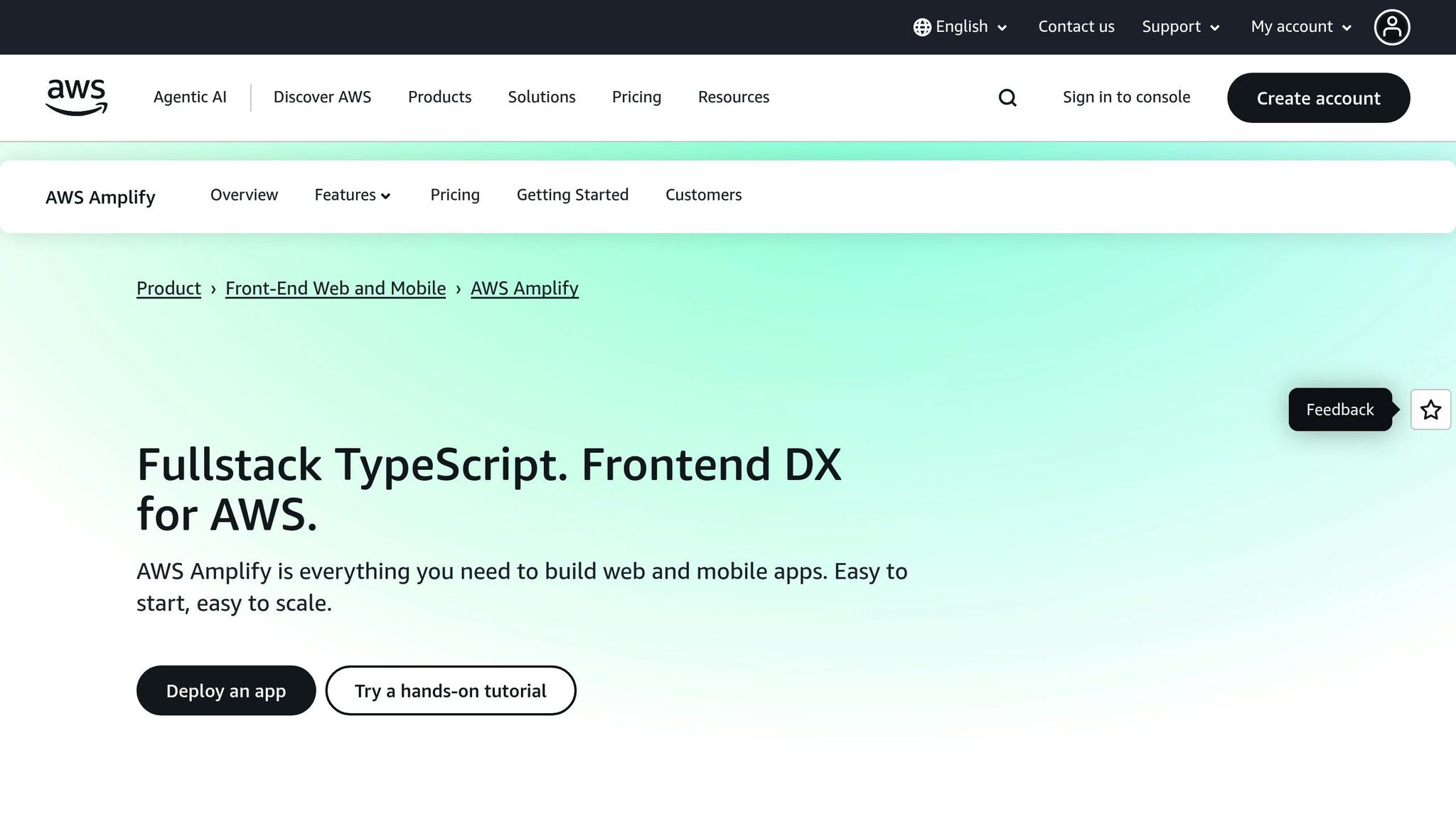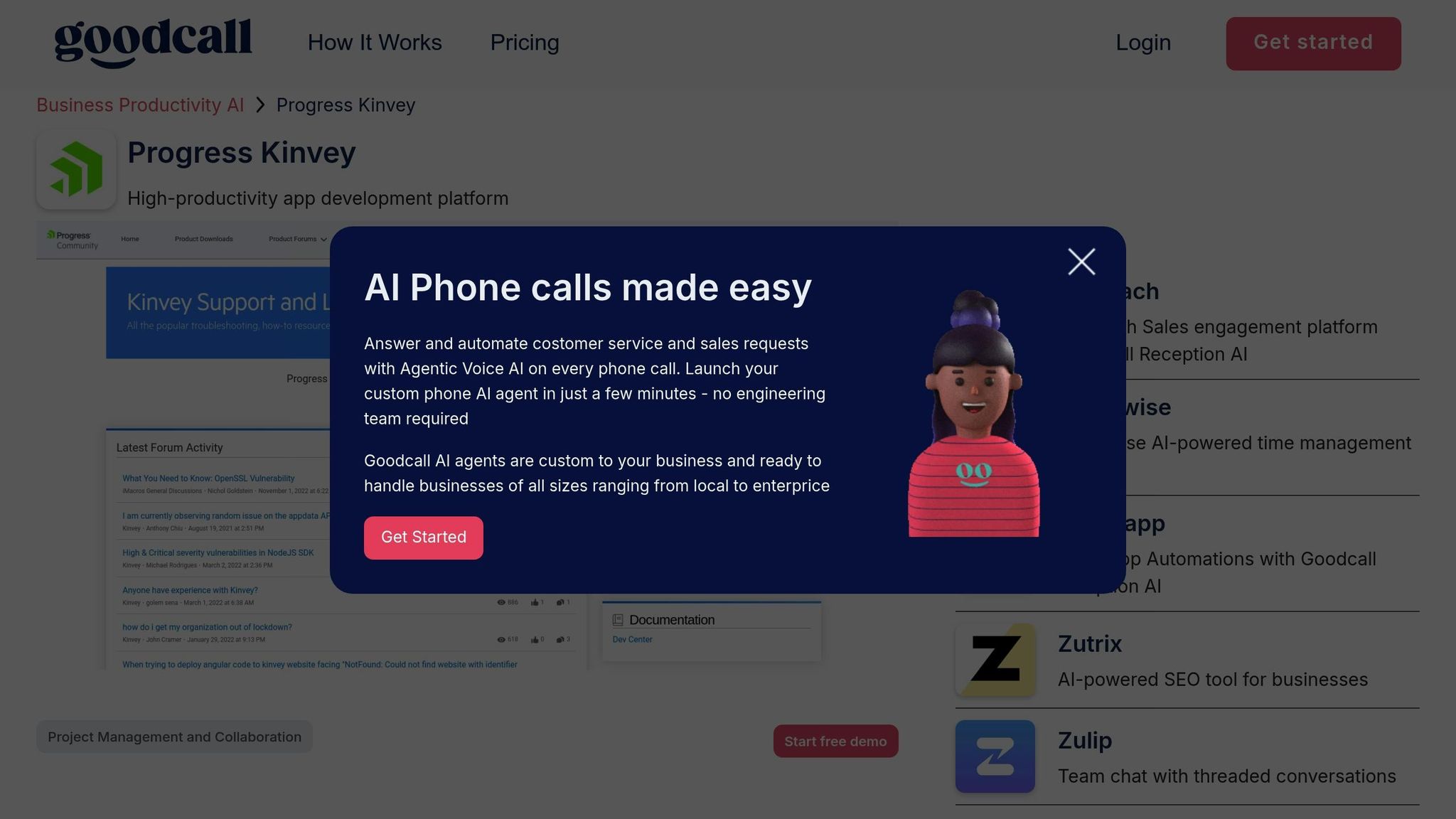AWS Amplify and Kinvey are two platforms designed to handle IoT data, but they serve different needs. AWS Amplify excels in security, scalability, and compliance, making it ideal for industries with strict regulatory requirements. Kinvey focuses on integrating IoT solutions with existing enterprise systems, simplifying workflows for businesses with legacy infrastructure.
Key Takeaways:
- AWS Amplify: Best for companies prioritizing security, compliance (e.g., HIPAA, SOX), and scalability. It integrates seamlessly with AWS services and supports real-time data processing with tools like AWS Lambda and AppSync.
- Kinvey: Best for businesses needing easy integration with enterprise systems like SAP or Salesforce. It offers federated data access and strong offline capabilities through its SDKs.
Quick Comparison:
| Feature | AWS Amplify | Kinvey |
|---|---|---|
| Scalability | Auto-scales with serverless architecture | Scales via microservice-based architecture |
| Data Storage | DynamoDB (NoSQL) and S3 for file storage | Federated access to enterprise and cloud data |
| Real-Time Processing | AppSync with GraphQL subscriptions | FlexServices with Node.js microservices |
| Security | Multi-layered with Cognito and KMS | Secure Gateway and RapidAuth for authentication |
| Compliance | Supports HIPAA, SOX, CCPA | Strong focus on enterprise compliance |
| Integration | AWS ecosystem (Lambda, EventBridge, etc.) | Enterprise systems (SAP, Salesforce, etc.) |
| Offline Support | Native SDKs with offline sync | Two-way synchronization in SDKs |
If you're building IoT applications, your choice depends on whether you need a secure, scalable cloud ecosystem or robust integration with existing enterprise systems.
Amplify your Mobile App - IoT on AWS - A Philly Cloud Computing Event
1. AWS Amplify

AWS Amplify is Amazon's full-stack platform designed to simplify IoT application development within the AWS ecosystem. Its serverless architecture automatically scales to handle varying IoT workloads, eliminating the need for manual infrastructure management.
IoT Data Storage
AWS Amplify provides flexible storage options tailored for IoT data. It integrates effortlessly with Amazon DynamoDB, a NoSQL database that delivers ultra-low latency - ideal for managing high-frequency IoT sensor data. With its GraphQL API, Amplify automatically generates resolvers that link to these storage backends, saving developers from writing custom connection code. This setup is perfect for handling device telemetry, user settings, and application state data, speeding up development.
For file storage, Amplify utilizes Amazon S3, paired with CloudFront for content delivery. This setup is particularly useful for IoT applications that manage firmware updates, device configurations, or multimedia content from connected cameras and sensors. Together, these tools ensure efficient real-time processing and reliable storage.
Data Processing and Real-Time Analytics
AWS AppSync enables real-time GraphQL subscriptions, ensuring instant data updates. IoT devices can send data changes that are immediately reflected in web and mobile apps, eliminating the need for constant polling. This ensures users always see the most current device statuses and sensor readings.
Developers can enhance Amplify’s capabilities with AWS Lambda, which allows for processing incoming data, performing calculations, and triggering alerts based on set thresholds. For instance, a smart building app could analyze sensor data and adjust HVAC systems in real time.
Additionally, Amazon Pinpoint integration supports automated notifications triggered by IoT events. If a sensor detects an anomaly or a device goes offline, the system can quickly send push notifications, SMS messages, or emails to relevant parties. This is particularly critical in industrial IoT scenarios where immediate action is often required.
Security and Compliance
AWS Amplify incorporates multiple layers of security for IoT environments. Authentication is managed through Amazon Cognito, which supports multi-factor authentication and custom flows. Devices are authenticated using temporary credentials that rotate automatically, reducing security risks.
The platform also offers fine-grained access controls, allowing administrators to assign permissions based on device type or user role. This ensures that each sensor or user accesses only the data necessary for their function.
Data protection is a priority, with encryption applied both in transit and at rest. Amplify uses AES-256 encryption for stored data and TLS 1.2 for secure communications. For organizations needing advanced security, AWS Key Management Service (KMS) is available for managing custom encryption keys.
Amplify also supports compliance with US regulations like HIPAA and SOX, thanks to AWS’s extensive certifications. Developers can use AWS CloudTrail to maintain detailed logs of API calls and data access, ensuring regulatory requirements are met. These robust security and compliance features make Amplify a reliable choice for IoT applications.
Integration and Ecosystem Support
One of Amplify's standout features is its seamless integration with the broader AWS ecosystem. Applications built on Amplify can easily connect to a variety of AWS services, enabling complex IoT workflows. For example, integration with Amazon EventBridge allows IoT events to trigger actions across multiple AWS services, making automation scenarios more achievable.
For mobile development, Amplify offers native SDKs for iOS, Android, and React Native, with built-in offline synchronization. This ensures IoT mobile apps can cache data locally and sync updates automatically when connectivity is restored.
Developers can set up continuous integration and deployment (CI/CD) pipelines using AWS CodeCommit, CodeBuild, and CodePipeline. This streamlines the process of testing and deploying IoT applications across different environments, from development to production.
Amplify also supports popular frameworks like React, Angular, Vue.js, and Flutter, giving developers the flexibility to use their preferred tools. Its CLI tools further simplify resource management by automating code generation and deployment, reducing the complexity of building and maintaining IoT applications on AWS.
2. Kinvey

Kinvey has been a leader in mobile Backend as a Service (mBaaS) for over six years. It connects mobile, web, and IoT apps to backend resources using unified APIs and SDKs. Built on a microservice architecture and a serverless cloud platform, Kinvey is designed to automatically scale based on demand. Let’s dive into how Kinvey handles IoT data.
IoT Data Storage
When it comes to data storage, Kinvey takes a smart approach by offering federated access to both enterprise and cloud services. Instead of forcing organizations to migrate their existing data, it connects IoT applications to current backend systems through unified APIs. Its RapidData services simplify integration with major enterprise platforms like SAP and Salesforce, as well as various NoSQL databases, eliminating the need for complex API development.
Kinvey also ensures secure access to internal data sources with its Secure Gateway, which establishes encrypted connections to systems like Microsoft SQL Server - no need to tweak firewalls or set up VPNs. Plus, its client SDKs provide strong offline capabilities, including two-way synchronization between devices and backend datastores. This ensures data stays consistent, even when the network is unreliable.
Data Processing and Real-Time Analytics
Kinvey uses FlexServices, lightweight Node.js microservices, to integrate data and business logic while leveraging the vast NPM ecosystem. This setup supports advanced data processing workflows and real-time analytics. The Kinvey Microservice Framework allows for scalable and modular development, abstracting the complexities of backend systems. This means developers can focus more on frontend work, as highlighted in the platform's documentation:
development teams no longer need to know the nuances of enterprise systems data access paradigms, allowing them to focus 100% on frontend work.
Security and Compliance
Security is a top priority for Kinvey. Its RapidAuth services connect applications to existing identity and single sign-on solutions, supporting various authentication protocols like OAuth2, SAML, OpenID Connect, Active Directory, LDAP, and even Facebook Auth. For added protection, the Secure Gateway enables encrypted connections to internal data sources without exposing them to the internet. This feature is especially critical for industrial IoT applications that handle sensitive operational data.
Integration and Ecosystem Support
The Kinvey high productivity platform makes it easy for Node developers to create native apps across multiple platforms while staying in control.
Kinvey’s RapidServices framework offers low- to no-code tools to simplify integration between IoT apps and existing business systems. Its Command Line Interface (CLI) integrates seamlessly into CI/CD pipelines with tools like Jenkins and Travis, allowing teams to store application metadata in version control systems like GitHub for consistent deployments. Additionally, by abstracting backend complexities, Kinvey creates a reusable service catalog that shields frontend developers from the intricacies of enterprise system integration. This ensures IoT applications remain adaptable to future backend updates.
sbb-itb-8abf120
Advantages and Disadvantages
Here's a quick look at what each platform brings to the table:
AWS Amplify stands out for its strong focus on security and compliance. Its measures are backed by third-party audits, making it a solid choice for organizations that need to meet strict regulatory standards.
Kinvey, on the other hand, shines when it comes to integrating with enterprise systems. This makes it a great option for businesses that rely heavily on their existing IT infrastructure.
In short, go with AWS Amplify if your priority is top-notch security and compliance. Opt for Kinvey if seamless enterprise integration is what you need.
Conclusion
Choosing between AWS Amplify and Kinvey ultimately depends on your IoT data handling needs and the infrastructure you already have in place.
AWS Amplify is a strong contender if your focus is on meeting strict US security and compliance requirements. It’s particularly appealing to industries with high data protection demands. For teams already working within the AWS ecosystem, its scalable infrastructure makes it a natural fit for growing IoT deployments.
On the other hand, Kinvey shines when it comes to integrating IoT solutions with existing enterprise systems. Its integration tools are designed to simplify the process for organizations relying on legacy IT setups, making it a practical choice for established businesses that prioritize continuity.
The right platform for you will depend on whether you value a robust, secure cloud ecosystem or seamless integration with your current enterprise systems. Both platforms address key IoT challenges effectively, so your decision should align with your technology stack and operational goals.
If you're looking for expert guidance in implementing IoT solutions, partnering with experienced professionals can make all the difference. At Zee Palm (https://zeepalm.com), our team of 13 specialists, including over 10 seasoned developers with a collective decade of experience, has delivered 100+ successful projects to more than 70 satisfied clients. We help US businesses tackle complex IoT data challenges while ensuring compliance and operational efficiency. Let us help you align your data strategy with your business objectives.
FAQs
What should I consider when deciding between AWS Amplify and Kinvey for managing IoT data?
When deciding between AWS Amplify and Kinvey for managing IoT data, it's essential to align your choice with your project's unique requirements.
AWS Amplify shines in scenarios requiring real-time data processing, modern APIs, and tools that speed up development. It's a solid option for building scalable, cloud-native IoT applications.
Meanwhile, Kinvey is designed with enterprise needs in mind. It features a serverless architecture, strong security measures, and advanced data management capabilities, making it a great fit for projects that demand enterprise-level reliability and complex data handling.
Ultimately, your choice depends on whether you value rapid development and seamless cloud integration (AWS Amplify) or need robust security and advanced data operations for enterprise solutions (Kinvey).
How does AWS Amplify ensure compliance with regulations for industries managing sensitive IoT data?
AWS Amplify helps businesses meet stringent industry regulations by tapping into AWS's well-established compliance programs, such as SOC, PCI, ISO, and HIPAA. These certifications are routinely reviewed by independent auditors to confirm adherence to top-tier security and privacy standards.
To safeguard sensitive IoT data, AWS uses TLS encryption for data in transit and provides hardware security modules (HSM) for enhanced protection. The platform operates under a shared responsibility model, ensuring both AWS and its users contribute to maintaining compliance. Moreover, AWS IoT services are built to align with the requirements of more than 50 audit programs, offering extensive security measures and regulatory support for managing IoT data effectively.
How does Kinvey make it easier to integrate IoT solutions with enterprise systems like SAP and Salesforce?
Kinvey makes it easier to connect IoT solutions with enterprise systems like SAP and Salesforce by providing pre-built connectors and REST API integrations. These tools streamline data exchange between IoT devices and enterprise platforms, cutting down on the need for heavy custom development.
On top of that, Kinvey includes low-code microservices like RapidAuth for authentication and RapidData for handling data processes. These features speed up setup and simplify management, allowing businesses to integrate IoT solutions with their existing systems more efficiently.



